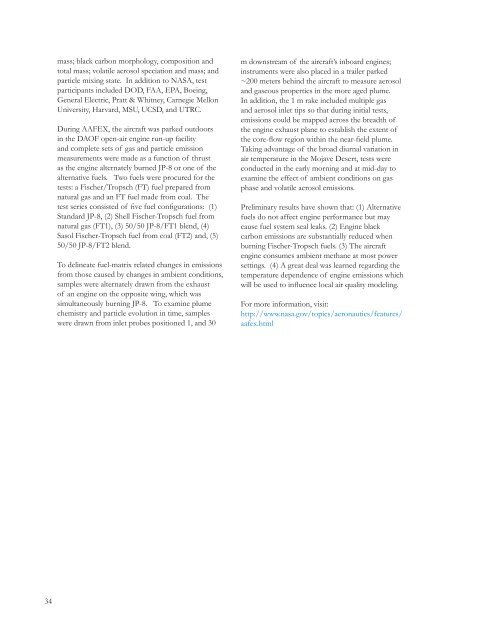2009 Annual Report - NASA Airborne Science Program
2009 Annual Report - NASA Airborne Science Program
2009 Annual Report - NASA Airborne Science Program
You also want an ePaper? Increase the reach of your titles
YUMPU automatically turns print PDFs into web optimized ePapers that Google loves.
mass; black carbon morphology, composition and<br />
total mass; volatile aerosol speciation and mass; and<br />
particle mixing state. In addition to <strong>NASA</strong>, test<br />
participants included DOD, FAA, EPA, Boeing,<br />
General Electric, Pratt & Whitney, Carnegie Mellon<br />
University, Harvard, MSU, UCSD, and UTRC.<br />
During AAFEX, the aircraft was parked outdoors<br />
in the DAOF open-air engine run-up facility<br />
and complete sets of gas and particle emission<br />
measurements were made as a function of thrust<br />
as the engine alternately burned JP-8 or one of the<br />
alternative fuels. Two fuels were procured for the<br />
tests: a Fischer/Tropsch (FT) fuel prepared from<br />
natural gas and an FT fuel made from coal. The<br />
test series consisted of five fuel configurations: (1)<br />
Standard JP-8, (2) Shell Fischer-Tropsch fuel from<br />
natural gas (FT1), (3) 50/50 JP-8/FT1 blend, (4)<br />
Sasol Fischer-Tropsch fuel from coal (FT2) and, (5)<br />
50/50 JP-8/FT2 blend.<br />
To delineate fuel-matrix related changes in emissions<br />
from those caused by changes in ambient conditions,<br />
samples were alternately drawn from the exhaust<br />
of an engine on the opposite wing, which was<br />
simultaneously burning JP-8. To examine plume<br />
chemistry and particle evolution in time, samples<br />
were drawn from inlet probes positioned 1, and 30<br />
m downstream of the aircraft’s inboard engines;<br />
instruments were also placed in a trailer parked<br />
~200 meters behind the aircraft to measure aerosol<br />
and gaseous properties in the more aged plume.<br />
In addition, the 1 m rake included multiple gas<br />
and aerosol inlet tips so that during initial tests,<br />
emissions could be mapped across the breadth of<br />
the engine exhaust plane to establish the extent of<br />
the core-flow region within the near-field plume.<br />
Taking advantage of the broad diurnal variation in<br />
air temperature in the Mojave Desert, tests were<br />
conducted in the early morning and at mid-day to<br />
examine the effect of ambient conditions on gas<br />
phase and volatile aerosol emissions.<br />
Preliminary results have shown that: (1) Alternative<br />
fuels do not affect engine performance but may<br />
cause fuel system seal leaks. (2) Engine black<br />
carbon emissions are substantially reduced when<br />
burning Fischer-Tropsch fuels. (3) The aircraft<br />
engine consumes ambient methane at most power<br />
settings. (4) A great deal was learned regarding the<br />
temperature dependence of engine emissions which<br />
will be used to influence local air quality modeling.<br />
For more information, visit:<br />
http://www.nasa.gov/topics/aeronautics/features/<br />
aafex.html<br />
34











